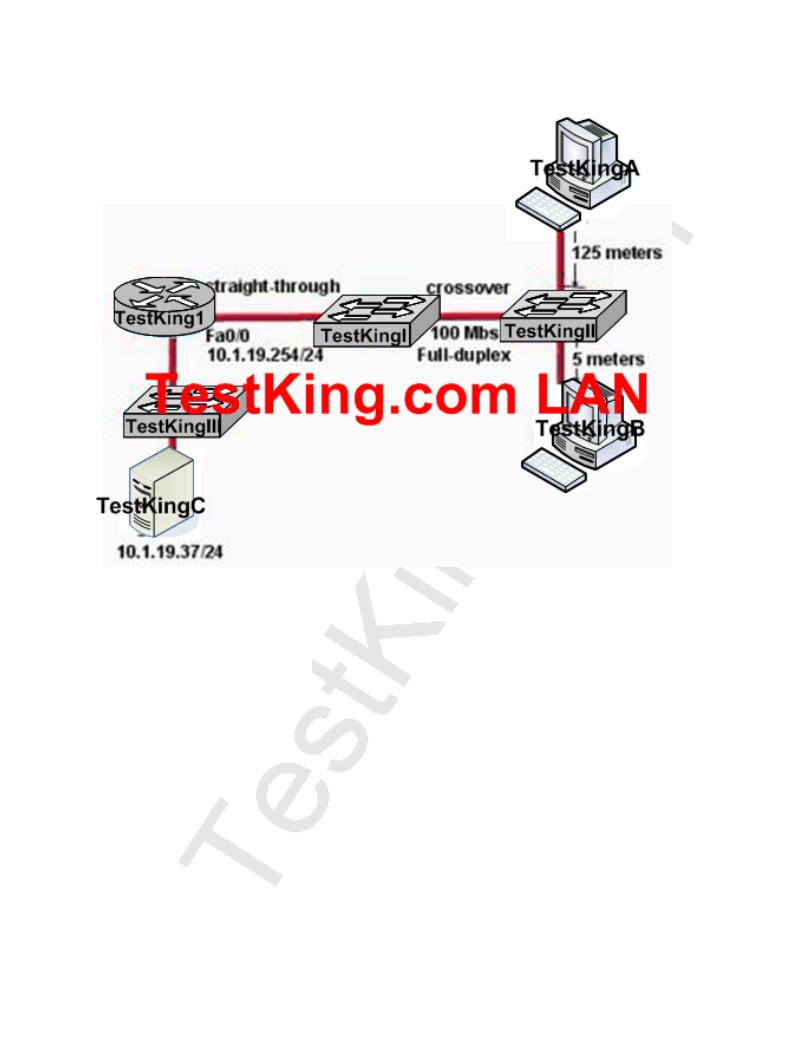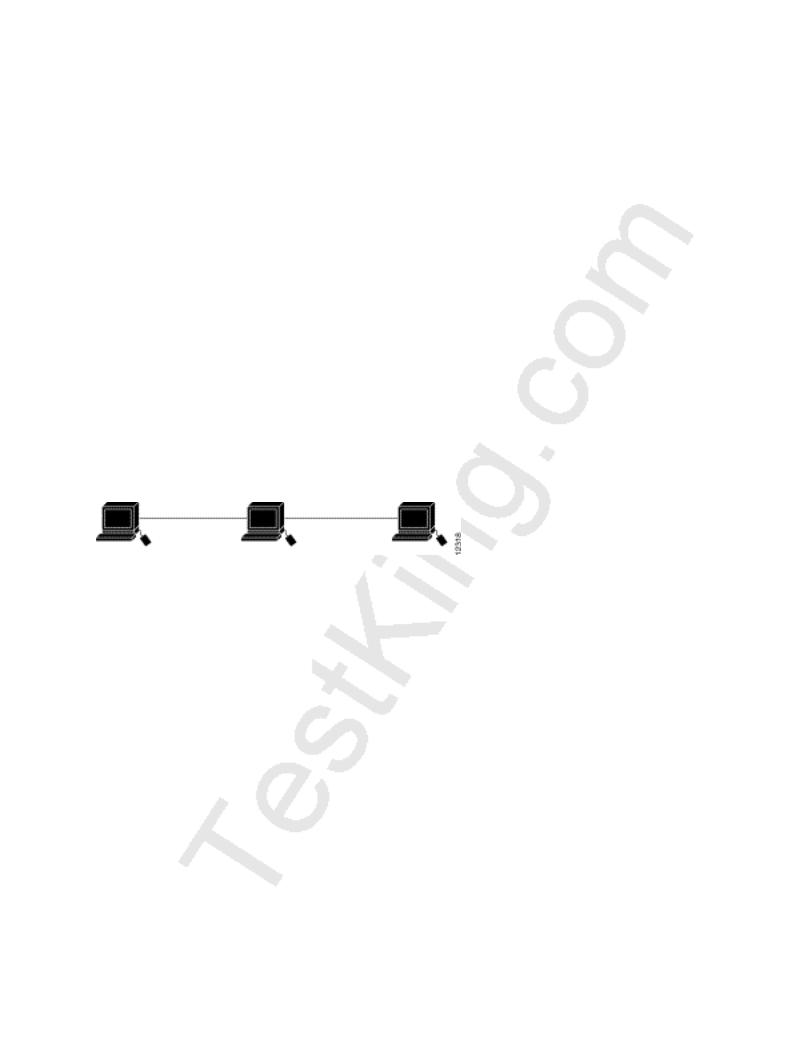
Testking_640-802_V13
.pdf
On the basis of the information provided in the exhibit above, what is the problem?
A.The connection between Switch1 and Switch2 should be half-duplex.
B.The cable between Router1 and Switch1 should be a crossover.
C.The cable connecting Host A to Switch2 is too long.
D.The server is on a different subnet than router interface Fa0/0.
E.The cable between Switch1 and Switch2 should be straight-through.
F.None of the above
Answer: C
Explanation:
Leading the way in IT testing and certification tools, www.testking.com
- 101 -

According to IEEE specifications, the maximum segment length of an Ethernet cable should not exceed 100 meters. The total distance between an Ethernet Transmitter and Receiver at the absolute end points of the network (maximum diameter from origin to final destination, if the wires were stretched out to form a straight line) should be no more than100 Meters (328 ft., 109 yards, or about the length of a football field). This limitation results from the timing of the Ethernet signals on the cable and not necessarily the cable characteristics, and is, therefore, a "hard" number.
QUESTION NO: 4
What is the IEEE standard associated with Gigabit Ethernet? (Select two answer choices)
A.802.11
B.802.5
C.802.3ab
D.802.3ae
E.802.3z
F.802.3u
Answer: C, E
Explanation:
The IEEE 802.3z standard describes 1000BASE-SX.
The 1000BaseT standard was released in June 1999, defined by IEEE 802.3ab.
Incorrect Answers:
A.This describes the standard used for wireless networks.
B.This is the standard for token ring networks.
D. On June 17, 2002 the IEEE 802.3ae specification for 10 Gigabit Ethernet was approved as an IEEE standard by the IEEE Standards Association (IEEE-SA) Standards Board.
F. IEEE 802.3u describes the standard for 100BASE-TX.
QUESTION NO: 5
Which of the following can lead to the contribution of LAN traffic congestion? (Select all that apply)
A.Too many hosts in a broadcast domain
B.Full duplex operation
Leading the way in IT testing and certification tools, www.testking.com
- 102 -

C.Broadcast storms
D.Multicasting
E.Segmentation
F.Low bandwidth
Answer: A, C, F Explanation:
Choice A is correct because the more hosts on a broadcast domain, the more traffic that is created. Choice Ccontributes to congestion because broadcast storms can become very problematic, and lead to complete network saturation. Multicasts are similar to broadcasts in their use on a LAN. Finally, if there is not enough bandwidth, traffic sessions can time out. This leads to new transmissions and the re-sending of data, which can lead to more congestion.
Incorrect Answers:
B, E. These are incorrect because full duplex operation and segmented networks actually result in less congestion.
D. Multicasting can actually alleviate congestion issues, as single streams of information can reach multiple hosts at the same time, instead of using a series of point to point connections.
QUESTION NO: 6
On a half-duplex Ethernet LAN, two hosts attempt to send data simultaneously, resulting in a collision. Following this collision, what will the hosts do? (Select all valid answers)
A.The destination host sends a request to the source for retransmission.
B.The jam signal indicates that the collision has been cleared.
C.The hosts will attempt to resume transmission after a time delay has expired.
D.An electrical pulse indicates that the collision has cleared.
E.The router on the segment will signal that the collision has cleared.
F.The hosts will do nothing, as the higher layers are responsible for data error correction and re-transmission.
Answer: C Explanation:
When a host on an Ethernet LAN has information to send, the following steps are taken:
1.A device with a frame to send listens until Ethernet is not busy.
2.When the Ethernet is not busy, the sender begins sending the frame.
Leading the way in IT testing and certification tools, www.testking.com
- 103 -

3.The sender listens to make sure that no collision occurred.
4.Once the senders hear the collision, they each send a jamming signal, to ensure that all stations recognize the collision.
5.After the jamming is complete, each sender randomizes a timer and waits that long.
6.When each timer expires, the process starts over with step 1.
QUESTION NO: 7
Which of the following statements correctly describe the differences between half-duplex and full-duplex Ethernet? (Select two answer choices.)
A.Full-duplex Ethernet uses CSMA/CD to prevent collisions.
B.Half-duplex Ethernet uses a loopback circuit to detect collisions.
C.A full-duplex Ethernet card allows 20Mbps for data transmission.
D.Full-duplex Ethernet makes use of two pairs of wires for data.
E.An Ethernet hub can operate both half and full duplex simultaneously.
Answer: B, D
Explanation:
Half-duplex Ethernet send and receives on the same line, so a loopback needs to be set to detect collisions. Alternatively, full-duple Ethernet doesn't have to because it uses two pairs of wire, one to send and the other to receive. Collisions are not possible on full duplex Ethernet networks.
Incorrect Answers:
A. Full duplex uses both pairs of wires, so transmissions are sent on the first pair, and data that is received come in on the other pair. This prevents collisions.
C. Full duplex allows for data to be sent and received at the same time. It will not double the amount of bandwidth at any given time. The speed of the Ethernet link will remain at 10/100.
E. Hubs are shared devices and can only support one mode, unlike switches.
QUESTION NO: 8
Why is full-duplex Ethernet superior to its single-duplex counterpart? (Select two answer choices.)
A.It uses inexpensive hubs
B.It operates without collisions
C.It operates on switches
Leading the way in IT testing and certification tools, www.testking.com
- 104 -

D.It provides faster data transfer
E.It utilizes fewer wiring pairs
Answer: B, D
Explanation:
Full duplex Ethernet allows concurrent sending and receiving, which allows the full bandwidth to be used for both sending and receiving. The result is a collision free network with increased throughput.
Incorrect Answers:
A, C. These are incorrect because full duplex doesn't require hubs or switches. Full duplex operation can be used on switch and router ports, as well as PC hosts.
E. This is incorrect because full duplex actually uses more wiring pairs. In full duplex, both wire pairs are used. Half duplex uses only a single pair.
QUESTION NO: 9
When you compare the differences between half-duplex and full-duplex Ethernet, which of the following characteristics are exclusive to half-duplex? (Select two answer choices)
A.Half-duplex Ethernet operates in a shared collision domain.
B.Half-duplex Ethernet operates in an exclusive broadcast domain.
C.Half-duplex Ethernet has efficient throughput.
D.Half-duplex Ethernet has lower effective throughput.
E.Half-duplex Ethernet operates in an exclusive collision domain.
Answer: A, D
Explanation:
A single device could not be sending a frame and receiving a frame at the same time because it would mean that a collision was occurring. So, devices simply chose not to send a frame while receiving a frame. That logic is called half-duplex logic.
Ethernet switches allow multiple frames to be sent over different ports at the same time. Additionally, if only one device is connected to a switch port, there is never a possibility that a collision could occur. So, LAN switches with only one device cabled to each port of the switch allow the use of full-duplex operation. Full duplex means that an Ethernet card can send and receive concurrently.
Incorrect Answers:
B. Full duplex effectively doubles the throughput of half-duplex operation, because data can be both sent and received at the full 10/100 speed.
Leading the way in IT testing and certification tools, www.testking.com
- 105 -

C, E. In half duplex operation, the network is shared between all devices in the collision domain.
Reference: CCNA Self-Study CCNA INTRO exam certification Guide (Cisco Press, ISBN 1-58720-094-5) Page 62-63.
QUESTION NO: 10
Two stations on the TestKing LAN transmit at the same time, resulting in a collision. What happens when a collision occurs on the network? (Choose all that apply)
A.Each device on the Ethernet segment stops transmitting for a short time.
B.A jam signal informs all devices that a collision occurred.
C.When data transmission resumes, the devices that were involved in the collision have priority to transmit.
D.The devices that are involved in the collision stops transmitting for a short time.
E.The collision invokes a random back-off algorithm.
Answer: B, D, E Explanation:
When a host on an Ethernet LAN has information to send, the following steps are taken:
1.A device with a frame to send listens until Ethernet is not busy.
2.When the Ethernet is not busy, the sender begins sending the frame.
3.The sender listens to make sure that no collision occurred.
4.Once the senders hear the collision, they each send a jamming signal, to ensure that all stations recognize the collision.
5.After the jamming is complete, each sender randomizes a timer and waits that long.
6.When each timer expires, the process starts over with step 1.
Incorrect Answers:
A. Only the stations involved in the collision stop transmitting for a short time, not all stations on the LAN.
C. No priority is given to any stations once a collision has occurred.
QUESTION NO: 11
Which of the following are true of Ethernet technology?
A.Hosts use a logical ring topology.
B.Hosts use a logical bus topology
Leading the way in IT testing and certification tools, www.testking.com
- 106 -

C.Hosts must wait for an electronic signal to transfer data.
D.Hosts are directly connected to a wiring concentrator called a MSAU.
E.None of the above
Answer: B Explanation:
LAN topologies define the manner in which network devices are organized. Four common LAN topologies exist: bus, ring, star, and tree. These topologies are logical architectures, but the actual devices need not be physically organized in these configurations. Logical bus and ring topologies, for example, are commonly organized physically as a star. A bus topology is a linear LAN architecture in which transmissions from network stations propagate the length of the medium and are received by all other stations. Of the three most widely used LAN implementations, Ethernet/IEEE 802.3 networks, including 100BaseT, implement a bus topology, which is illustrated in Figure 2-3.
Figure2-3: Some networks implement a local bus topology.
Reference: http://www.pulsewan.com/lanintro.htm
QUESTION NO: 12
With regard to Ethernet media access methods, which of the following are true? (Choose all that apply.)
A.A device waits for an electronic signal before transmitting.
B.A device listens and waits until the media is not busy before transmitting.
C.All devices on an Ethernet segment see data that passes on the network medium.
D.Only the sender and the receiver devices see data that passes on the network medium.
E.Ethernet networks allow you to configured devises with higher transmission priority.
Answer: B, C
Explanation:
Ethernet uses the CSMA/CD access method.
Leading the way in IT testing and certification tools, www.testking.com
- 107 -

CSMA/CD logic helps prevent collisions and also defines how to act when a collision does occur. The CSMA/CD algorithm words like this:
1.A device with a frame to send listens until the Ethernet is not busy.
2.When the Ethernet is not busy, the sender begins sending the frame.
3.The sender listens to make sure that no collision occurred.
4.Once the senders hear the collision, they each send a jamming signal, to ensure that all stations recognize the collision.
5.After the jamming is complete, each sender randomizes a timer and waits that long.
6 When each timer expires, the process starts over with Step 1.
So, all devices on the Ethernet need to use CSMA/CD to avoid collisions and to recover when inadvertent collisions occur.
Reference: Cisco CCNA intro 640-821 p.55
QUESTION NO: 13
Which two statements describe the operation of the CSMA/CD access method, which is in use on the TestKing network? (Choose two)
A.After a collision, the station that detected the collision has first priority to resend the lost data.
B.In a CSMA/CD collision domain, stations must wait until the media is not in use before transmitting.
C.In a CSMA/CD collision domain, multiple stations can successfully transmit data simultaneously.
D.The use of hubs to enlarge the size of collision domains is one way to improve the operation of the CSMA/CD access method.
E.After a collision, all stations run a random backoff algorithm. When the backoff delay period has expired, all stations have equal priority to transmit data.
F.After a collision, all stations involved run an identical backoff algorithm and then synchronize with each other prior to transmitting data.
Answer: B, E
Explanation:
Leading the way in IT testing and certification tools, www.testking.com
- 108 -

Ethernet networking uses Carrier Sense Multiple Access with Collision Detect (CSMA/CD), a protocol that helps devices share the bandwidth evenly without having two devices transmit at the same time on the network medium. CSMA/CD was
created to overcome the problem of those collisions
that occur when packets are transmitted simultaneously from different nodes. And trust me, good collision management is crucial, because when a node transmits in a CSMA/CD network, all the other nodes on the network receive and examine that transmission. Only bridges and routers can effectively prevent a transmission from propagating throughout the entire network! So, how does the CSMA/CD protocol work? Like this: when a host wants to transmit over the network, it first checks for the presence of a digital signal on the wire. If all is clear (no other host is transmitting), the host will then proceed with its transmission. But it doesn't stop there. The transmitting host constantly monitors the wire to make sure no other hosts begin transmitting. If the host detects another signal on the wire, it sends out an extended jam signal that causes all nodes on the segment to stop sending data (think, busy signal). The nodes respond to that jam signal by waiting a while before attempting to transmit again. Backoff algorithms determine when the colliding stations can retransmit. If collisions keep occurring after 15 tries, the nodes attempting to transmit will then time out.
QUESTION NO: 14
Which three statements are true about the operation of a full-duplex Ethernet network, which is being used in the TestKing LAN? (Choose three)
A.Ethernet hub ports are preconfigured for full-duplex mode.
B.The host network card and the switch port must be capable of operating in full-duplex mode.
C.There are no collisions in full-duplex mode.
D.In a full-duplex environment, the host network card must check for the availability of the network media before transmitting.
E.A dedicated switch port is required for each full-duplex node.
Answer: B, C, E
Explanation:
Leading the way in IT testing and certification tools, www.testking.com
- 109 -

Half-duplex Ethernet is defined in the original 802.3 Ethernet and Cisco says you only use one wire pair with a digital signal running in both directions on the wire. It also uses the CSMA/CD protocol to help prevent collisions and to permit retransmitting if a collision does occur. If a hub is attached to a switch, it must operate in half-duplex mode because the end stations must be able to detect collisions. Half-duplex Ethernet-typically 10BaseT-is only about 30 to 40 percent efficient as Cisco sees it, because a large 10BaseT network will usually only give you 3- to 4Mbps-at most.
Full-duplex Ethernet uses two pairs of wires, instead of one wire pair like half duplex. Also, full duplex uses a point-to-point connection between the transmitter of the transmitting device and the receiver of the receiving device, which means that with full-duplex data transfer, you get a faster data transfer compared to half duplex. And because the transmitted data is sent on a different set of wires than the received data, no collisions occur. The reason you don't need to worry about collisions is because now Full-duplex Ethernet is like a freeway with multiple lanes instead of the single-lane road provided by half duplex. Full-duplex Ethernet is supposed to offer 100 percent efficiency in both directions; this means you can get 20Mbps with a 10Mbps Ethernet running full duplex, or 200Mbps for FastEthernet.
Section 3: Explain network segmentation and basic traffic management concepts (5 questions)
QUESTION NO: 1
A TestKing office is split into a sales and a production department as shown below:
Leading the way in IT testing and certification tools, www.testking.com
- 110 -
